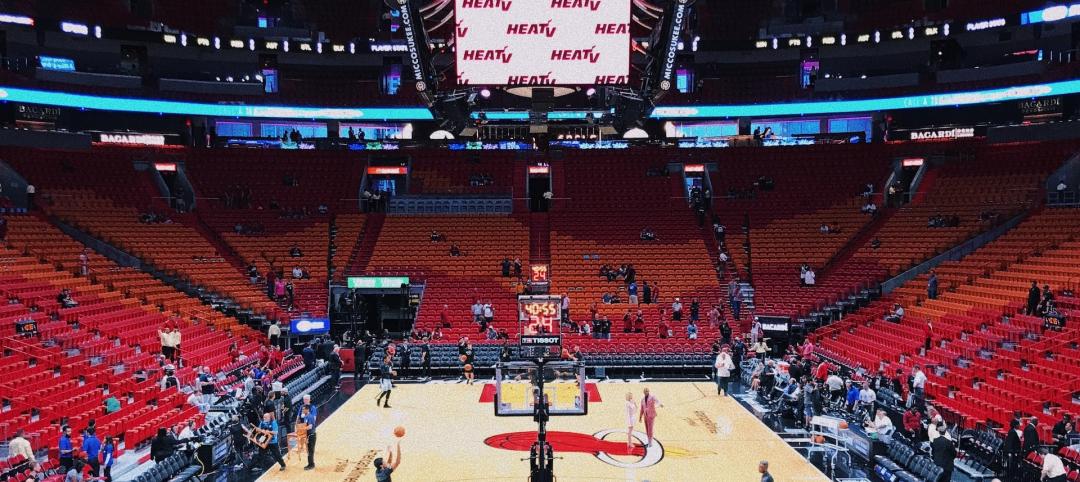On May 13, C.W. Driver, in partnership with Little Diversified Architectural Consulting, broke ground on the Kinesiology and Athletics Complex at Orange Coast College, a $36 million, 88,000-sf building within an Education sector that typically accounts for more than half of this Pasadena, Calif.-based general contractor’s annual revenue.
C.W. Driver, the oldest licensed builder headquartered in Southern California, is celebrating its 100th anniversary this year, and is showing little sign of slowing down. The company, with seven offices and 365 employees across California, generates between $700 million and $850 million per year in revenue.
In a consolidating industry where firms are frenetically acquiring new practices and disciplines to stay competitive, C.W. Driver remains an anomaly: a GC that builds almost exclusively in one state. Its portfolio includes academic, entertainment and sports, retail, civic and cultural, office, commercial hospitality and gaming, healthcare, residential and senior living.
“It’s not that we haven’t tried in the past” to diversify, says Karl Kreutziger, the firm’s president, who spoke with BD+C last week. At one time, C.W. Driver was self-performing concrete and drywall. It also once had an international business in Singapore.
Kreutziger, who has been with the firm since 2011, attributes its longevity to sticking with its core competencies and focusing the bulk of its work in the Greater Los Angeles market. (Eighty percent of its revenue comes from repeat customers.)
The company also has management continuity, starting with its CEO Dana Roberts, who has been with C.W. Driver for 48 years. In the 1990s, Roberts brought in two partners: CFO Bessie Kouvara, who retired in 2017; and Executive Vice President John Janacek, who oversees estimating.

Karl Kreutziger, C.W.Driver's president since 2011, attributes his company's longevity, in part, to its careful selection of projects. Image: C.W. Driver
The company was founded in 1919 by John McDonald and Clarence Wike Driver, the latter of whom had been working for one of the oldest architectural firms in L.A. During its first decade in business, C.W. Driver worked mostly on smaller projects. Driver’s son, Douglas, led the company through its next era and was active until 1987, when he turned over the reins to Roberts.
At a time when recruiting and retaining talent are challenges for many AEC firms, C.W. Driver has been able to hold onto its employees in part by offering some of them ownership in the company. It currently has 25 owners. And over the past two years, says Kreutziger, “we’ve had some ‘boomerangs,’ people who had left the company and have returned.” The fact that it offers full health insurance to all of its employees doesn’t hurt, either.
Like other GCs, C.W. Driver must deal with labor shortages. Keeping its trades on board, says Kreutziger, starts with a focused business development strategy “that identifies the projects we can be successful doing.” That requires early involvement at the preconstruction level, and then “committing to our key trade partners,” he says.
To avoid commoditizing its services, C.W. Driver steers away from design-bid-build projects, which account for less than 2% of its annual revenue. And while it has done work in Nevada, C.W. Driver usually passes on projects outside of its primary markets because, explains Kreutziger, “we just can’t get the [subs] to go there.”
As it moves into its second century, C.W. Driver wants to continue to grow organically. Kreutziger says the firm has been spending more time lately on succession planning and employee training. It also wants to make sure it is ahead of emerging markets like modular and panelized construction.
The firm is open, albeit cautiously, to new ventures that include acquisition. In August 2013, C.W. Driver acquired Good & Roberts, a 34-year-old San Diego-based construction company, which helped to bolster a market where C.W. Driver had been growing since 2006.
C.W. Driver also operates Driver SPG, an internal group it formed in 2011 that specializes in tenant improvement projects ranging from $500,000 to $15 million. Driver SPG represents about $80 million of C.W. Driver’s annual revenue, and “there’s a lot of crossover clients,” says Kreutziger.

C.W. Driver is the oldest liscensed builder headquartered in Southern California, a state where the GC continues to do most of its work. Image: C.W. Driver
Related Stories
University Buildings | Nov 13, 2022
University of Washington opens mass timber business school building
Founders Hall at the University of Washington Foster School of Business, the first mass timber building at Seattle campus of Univ. of Washington, was recently completed. The 84,800-sf building creates a new hub for community, entrepreneurship, and innovation, according the project’s design architect LMN Architects.
Giants 400 | Nov 9, 2022
Top 50 Data Center Contractors + CM Firms for 2022
Holder, Turner, DPR, and HITT Contracting head the ranking of the nation's largest data center contractors and construction management (CM) firms for 2022, as reported in Building Design+Construction's 2022 Giants 400 Report.
Giants 400 | Nov 8, 2022
Top 110 Sports Facility Architecture and AE Firms for 2022
Populous, HOK, Gensler, and Perkins and Will top the ranking of the nation's largest sports facility architecture and architecture/engineering (AE) firms for 2022, as reported in Building Design+Construction's 2022 Giants 400 Report.
Giants 400 | Nov 8, 2022
Top 60 Sports Facility Contractors and CM Firms for 2022
AECOM, Mortenson, Clark Group, and Turner Construction top the ranking of the nation's largest sports facility contractors and construction management (CM) firms for 2022, as reported in Building Design+Construction's 2022 Giants 400 Report.
Industry Research | Nov 8, 2022
U.S. metros take the lead in decarbonizing their built environments
A new JLL report evaluates the goals and actions of 18 cities.
Hotel Facilities | Nov 8, 2022
6 hotel design trends for 2022-2023
Personalization of the hotel guest experience shapes new construction and renovation, say architects and construction experts in this sector.
Green | Nov 8, 2022
USGBC and IWBI will develop dual certification pathways for LEED and WELL
The U.S. Green Building Council (USGBC) and the International WELL Building Institute (IWBI) will expand their strategic partnership to develop dual certification pathways for LEED and WELL.
Reconstruction & Renovation | Nov 8, 2022
Renovation work outpaces new construction for first time in two decades
Renovations of older buildings in U.S. cities recently hit a record high as reflected in architecture firm billings, according to the American Institute of Architects (AIA).
Sponsored | Steel Buildings | Nov 7, 2022
Steel structures offer faster path to climate benefits
Faster delivery of buildings isn’t always associated with sustainability benefits or long-term value, but things are changing. An instructive case is in the development of steel structures that not only allow speedier erection times, but also can reduce embodied carbon and create durable, highly resilient building approaches.
Building Team | Nov 7, 2022
U.S. commercial buildings decreased energy use intensity from 2012 to 2018
The recently released 2018 Commercial Buildings Energy Consumption Survey (CBECS) by the U.S. Energy Information Administration found that the total floorspace in commercial buildings has increased but energy consumption has not, compared with the last survey analyzing the landscape in 2012.

















